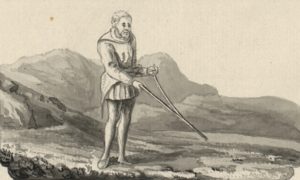In Defense of the Water Witches

In 2017, a couple in Stratford upon Avon, England requested that a technician from Severn Trent, the water company that serves their region, come out to replace the water line to their house from the main under the street. First, he had to locate the buried pipe, and the couple were surprised to see the technician walk over the street with a couple of bent rods.
Woe to the water witch in the age of social media. The couple, perplexed and amused to see this spectacle, announced it on their family WhatsApp group, where it seized the attention of their daughter Sally Le Page, an evolutionary biologist at Oxford. Le Page tweeted Severn Trent: “Why, @stwater, in 2017, are you using divining rods to ‘find’ the location of underwater pipes when there is zero evidence they work?”
The response from the company was “We’ve found that some of the older methods are just as effective than the new ones, but we do use drones as well, and now satellites” and referred Le Page to a website for more information on their methods. When Le Page doubled down on her incredulity, the water company was more than happy to elaborate: “We do have some techs that still have them in the van and use them if they need to, however we prefer to use listening sticks and other methods.”
In an article she wrote for Medium, Le Page writes that she then contacted 11 other major water companies in the UK asking them whether they employ dowsing, and all but two admitted that their technicians sometimes dowsed for buried pipes even though they mostly relied on approved higher-tech methods. Her response pulled no punches:
I can’t state this enough: there is no scientifically rigorous, doubly blind evidence that divining rods work. That’s how my scientist side would describe it. My non-scientist side would describe it thus: divining rods do not and will not work. Even now, any explanations of water dowsing rely on the supernatural, and in 2017, I am astonished to find two water companies relying on (and paying for) the supernatural to find underground pipes.
Le Page’s extraction of an admission from 21st century utilities that they sometimes use a scientifically unsupported practice “invented 450 years ago” (it goes back at least millennia, probably—see below) sparked a furore among UK skeptics and a flurry of reports in The Guardian and other media outlets. One Leeds University water management specialist quoted in The Guardian decried the use of “peculiar … Medieval witchcraft practices” by these companies. Science writer Philip Ball lent his voice to the chorus lamenting the lack of scientific understanding among even high-tech businesses like water companies: “It’s not impossible that an unknown law of physics is being profitably exploited by Severn Trent Water, but hopefully we can agree the likelihood is small.”
This outcry in turn provoked anxious and defensive tweets from the utility companies trying to put out what had become a PR disaster. They assured the skeptics that they did not approve of dowsing, and that it was only some backward, “rogue engineers” who still occasionally used the technique.
Interestingly, Le Page never says whether the dowsing water engineer found the pipe leading to her parents’ house. She does not complain that Severn Trent Water dug up the street in front of her folks’ house and came up empty handed, which would have added a certain substance to her complaints.
Unscientific Certainty
Every year or so, dowsing rises briefly to the attention of the mainstream media. Lois Parshley wrote a decently balanced piece in Aeon in 2015 about farmers’ use of dowsers in drought-parched central California. What prompted me to finally write this post was an article by Sasha von Oldershausen in The Atlantic last month (June, 2019), profiling a water witch working for an oil company in Texas. At best, as in these two pieces, it will just be noted how at odds dowsing is with modern science, without the authors explicitly passing judgment. (Parshley rightly notes even that “confirmation bias” applies to the skeptical scientists as much as to believers.) But at worst, as in Le Page’s article and other opinion pieces prompted by the UK case, authors heap condescension on the practice and imply that its practitioners (and other believers) are denizens of Carl Sagan’s demon-haunted world.
 Explanations for dowsing vary widely, and when confined to the stereotypical business of wandering over a landscape with a forked branch or bent metal rods, people’s minds may naturally go in various directions, depending on their prior level of skepticism. If they don’t dismiss it as nonsense, they may reasonably think it is a matter of the dowser translating some kind of unconscious (but non-paranormal) intuition about the landscape into subtle hand movements. Laypeople without any dog in the fight might assume it involves some subtle “energetic” tug of buried water on the branch or rods.
Explanations for dowsing vary widely, and when confined to the stereotypical business of wandering over a landscape with a forked branch or bent metal rods, people’s minds may naturally go in various directions, depending on their prior level of skepticism. If they don’t dismiss it as nonsense, they may reasonably think it is a matter of the dowser translating some kind of unconscious (but non-paranormal) intuition about the landscape into subtle hand movements. Laypeople without any dog in the fight might assume it involves some subtle “energetic” tug of buried water on the branch or rods.
Something like that latter mental image—waves of some sort, or perhaps some magnetic-like influence emanating from the ground—appears the earliest attempts to scientifically justify the practice and is probably how skeptics like Le Page imagine that most believers still imagine dowsing works. I would venture that such an image is the basis for her self-admittedly non-scientific certitude that “dowsing rods do not and will not work.”*
But consider my favorite of the “when impossible things happen to people with PhDs” genre, the late Elizabeth Lloyd Mayer’s wonderful book, Extraordinary Knowing. Meyer, a prominent Oakland, California psychotherapist, begins her book by relating her own experience with dowsing, which was so compelling that it drove her to devote years to researching psi phenomena. In 1991, her daughter had her prized harp stolen from an theater after a Christmas concert. She got no help from the police or even the local news media in recovering the valuable instrument for her distraught daughter, so a friend convinced her to try contacting a dowser.
Figuring she had nothing to lose, Mayer agreed to try a paranormal solution to her problem, so the friend gave her the phone number of Harold McCoy, then the president of the American Society of Dowsers in Fayetteville, Arkansas. Mayer reluctantly placed a long-distance call McCoy—by now, two months after the harp had been stolen—and after a moment’s thought the dowser was able to tell her the harp was still in Oakland. “Send me a street map of Oakland and I’ll locate the harp for you,” he said. She complied, and two days later McCoy called Mayer with directions to find the house that contained the stolen instrument. The police could not get a search warrant for the house simply on the basis of a dowser’s word, so Mayer posted flyers on the surrounding street corners offering a reward for the return of the harp.
After three days, a series of phone calls from the “neighbor” of the person in possession of the harp resulted in its delivery to her, in a hurried late-night rendezvous behind an all-night Safeway.
The reactions of Le Page, Ball, or any number of skeptics to a story like this are easy to imagine: the usual smug eye-rolling about confirmation bias, “the law of large numbers,” etc. If a scientifically educated person cannot accept those waves emanating from buried water pipes, how could they countenance such waves reaching from a lost harp in California across most of a continent to an Arkansas dowser’s hands holding a pendulum over a map of Oakland?
Dowsing really doesn’t make much scientific sense when we think of it as a problem of influences extending across space. It makes much more sense, though, when we do the counterintuitive thing of thinking of it as an influence extending across time, solely within the mind/brain of the dowser.
Dowsing the Future
In 2011, the prominent but not controversy-shy Cornell psychologist Daryl Bem published his now-infamous “Feeling the Future” findings: significant evidence from several large experiments that stimuli in the near future can influence present behavior. Most psychologists and many scientists were, you might say, “triggered” by this provocation and expressed condescending and even snarky outrage, since such a thing was obviously impossible. Yet despite a few pseudoskeptics’ claims to the contrary, Bem’s results have been replicated by a large number of independent researchers and laboratories—a story no one in mainstream psychology wants to hear.
 Bem’s findings were hardly the first to detect precognition—the support for that is massive, statistically—or even to detect presentiment, unconscious influences of future stimuli (here’s one recent review of the evidence). Over two decades ago, Dean Radin pioneered the study of future stimuli on autonomic responses like skin conductance, and by now there is a large and significant body of research just on this phenomenon, as shown by some recent meta-analyses. Anyone fairly assessing the evidence would have to conclude that retrograde influence from future stimuli exists and that it affects us on an unconscious level, influencing measurable outcomes like heart rate, brainwave activity, quickness to make certain motor responses, and so on.
Bem’s findings were hardly the first to detect precognition—the support for that is massive, statistically—or even to detect presentiment, unconscious influences of future stimuli (here’s one recent review of the evidence). Over two decades ago, Dean Radin pioneered the study of future stimuli on autonomic responses like skin conductance, and by now there is a large and significant body of research just on this phenomenon, as shown by some recent meta-analyses. Anyone fairly assessing the evidence would have to conclude that retrograde influence from future stimuli exists and that it affects us on an unconscious level, influencing measurable outcomes like heart rate, brainwave activity, quickness to make certain motor responses, and so on.
And as readers of my book Time Loops know, there is similarly provocative work just in the last decade from the frontiers of physics and biology attesting to both the reality of retrocausation at a quantum level (physical influences from future to past) and the possibility of biological systems scaling up “spooky” quantum effects. If it turns out the brain is indeed a kind of quantum computer (or hybrid quantum-classical computer, more likely)—and this is an active area of research by neuroscientists and cognitive scientists right now—then it is no longer at all ridiculous that animal nervous systems might be able to tap into future rewards. I suggest that’s what dowsing, when it boils down to it, really is: a future reward exerting an unconscious tug on the dowser’s present behavior via an automatic or autonomic response.
That response has a name, in fact: the ideomotor effect. This was first identified by psychical researchers in the 19th century studying mediums. Without our conscious awareness, our thoughts and feelings translate into small muscle movements that can both create an illusion of the body being manipulated by an external entity or force (such as when using a Ouija board) and can be used by another person (the medium) to “read” a sitter’s thoughts and feelings. I argue that dowsers holding rods, forked branches, pendulums, or a “magnetomatic pipe locator” (the instrument used by the Texas water witch in the recent Atlantic article) are using this “channel” to tap into an exciting reward in their near future: finding what they’re searching for, or what someone else has hired them to search for.
In other words, it is not true that “any explanations of water dowsing rely on the supernatural,” as Le Page claims. The natural is plenty roomy for new kinds of explanations.
Subtle Messages From Your Future Self
A big reason for parapsychology’s sluggishness to consider brain-based precognitive hypotheses as explanations for all sorts of ESP modalities (including dowsing) is the field’s historical failure to account for the experiential dimension of psi experiences. This was a gap lamented by pioneer remote viewer Ingo Swann, who felt that the lived experience of doing ESP was a crucial piece of the puzzle, and it is one gap I am trying to fill with my research. For instance, descriptions of ESP or mediumship experiments almost always leave out any information on how veridical information was confirmed by or to the individual psychic. It simply does not occur to most writers that this may be relevant; they think it is enough to say “the psychic was right” (if he or she was right) or that “the dowser was successful” (or not).
However, sometimes in the anecdotal literature, what I call a “scene of confirmation” is recorded as an afterthought, and this makes such anecdotal accounts priceless for studying these phenomena and how they may actually operate.
 For instance, Murray offhandedly notes later in her book that, after she successfully retrieved her daughter’s priceless harp based on the information provided by McCoy, she left an excited message on his answering machine. The dowser, she said, claimed he was not surprised to learn of his success, but who isn’t gratified to learn they’ve done a good job? There is no telling how much Mayer’s message on McCoy’s answering machine, or his emotional reactions to that message, might have been the crucial piece of what I am arguing is really a four-dimensional, loop-shaped puzzle. My somewhat reductive hypothesis is that ESP may only work when there will be some form of feedback forthcoming later, or some way of finding out piece of information that is hidden or missing in the present.
For instance, Murray offhandedly notes later in her book that, after she successfully retrieved her daughter’s priceless harp based on the information provided by McCoy, she left an excited message on his answering machine. The dowser, she said, claimed he was not surprised to learn of his success, but who isn’t gratified to learn they’ve done a good job? There is no telling how much Mayer’s message on McCoy’s answering machine, or his emotional reactions to that message, might have been the crucial piece of what I am arguing is really a four-dimensional, loop-shaped puzzle. My somewhat reductive hypothesis is that ESP may only work when there will be some form of feedback forthcoming later, or some way of finding out piece of information that is hidden or missing in the present.
In fact, I have come to think of dowsing, in its simplicity, as the “stem cell” of ESP phenomena. To invoke a popular idiom used by researchers in the fields of quantum computing, retrocausation, and time travel, the dowser’s brain at time point B is “post-selecting” on a reward, and that future reward is constraining their behavior at time point A to lead to that rewarding outcome. It’s probably not exactly a retrograde signal from the brain in the future to the brain now—it’s more exactly a correlation—but “subtle messages from our future self” is the easiest way for us nonphysicists to think about it. (Really, we need to overhaul our language entirely to think about retrocausation, as I’ve said before, but that’s a massive philosophical undertaking.)
We call it dowsing when it involves hunting for natural resources or lost items. When researchers stumble on the exact right page or piece of information in a book, we call it “the library angel” (a term coined by Arthur Koestler). When it involves an interaction between a psychic and a client where the interaction itself or later events produce rewarding confirmations or desired information, we call it mediumship. Most generally, it is simply intuition, our basic psychic search function.
When I said “it goes back at least millennia,” I was partly referring to possible images of dowsers in ancient art: A 6th Century C.E. synagogue at Bet Alpha in the Jezreel Valley possibly shows Aquarius holding a forked branch, and a Neolithic rock painting from Tassili, Algeria has been interpreted as depicting a dowser, although these interpretations are both controversial. But I was also referring to our earliest bacterial ancestors over two billion years ago. Post-selecting on the reward of survival in a few microseconds or milliseconds via quantum-computing microtubules would have conferred a small but important selective advantage on motile spirochetes wriggling through the primordial soup. You could call it dowsing for survival, and I suspect this scaling-up of quantum retrocausation will turn out to have been a basic factor in the arising of complex living systems.
True, we don’t yet know all the nuts and bolts of how precognition and presentiment work, either in cells or in people, and the brain-based hypothesis is speculative at this point. But it’s not by any means a ridiculous hypothesis, it’s ultimately testable, and there’s no supernatural anywhere to be found in it. Thus, when faced with “ancient superstitions” being applied by employees at water companies at a fraction of the cost or time as their other double-blind-proven high-tech tools, scientists and skeptical science writers might take a few deep breaths before shooting off their outraged op-eds. Why shouldn’t people use all the tools at our disposal, even the hard-to-understand, uncanny, and inexpensive tool of intuition, which may well stand on firm scientific footing one day in the not-too-distant future?
More power to the water witches, I say.
NOTE
* As I was writing this post, authors of a “special report” in Skeptical Inquirer took a similar “I can’t imagine how it would work so it’s therefore impossible” approach to debunking “all parapsychological claims” (just like that!). “Each and every claim made by psi researchers violates fundamental principles of science,” the authors Arthur S. Reber and James E. Alcock boldly declare, “and thus has no ontological status.” Their description of the anti-scientific reasoning that led to this conclusion is somewhat surreal, given that the publication portrays itself as a guardian of scientific rationality:
We did not examine the data for psi, to the consternation of the parapsychologist who was one of the reviewers. Our reason was simple: the data are irrelevant. We used a classic rhetorical device, adynaton, a form of hyperbole so extreme that it is, in effect, impossible. Ours was “pigs cannot fly”—hence data that show they can are the result of flawed methodology, weak controls, inappropriate data analysis, or fraud.
You can see the forefingers firmly jammed into ears. Real scientists know you need to do the work to find the flaws in published results, not simply declare them flawed because of your own biases. And no, Skeptical Inquirer readers, the evidence for psi has never been found, in bulk, to be fundamentally flawed or fraudulent. (If you’re getting your science news from SI, it’s a bit like getting your political news from Fox.)
Like many pseudoskeptics, these authors seem to not realize that science is a method of inquiry, not a list of fixed conclusions about the natural world. The history of science shows that the latter always change, so it’s a bit silly to think they won’t change further. The great Carl Sagan, who embraced real inquiry and dialogue as part of skepticism, would be appalled at the backward-looking (and seemingly, fearful) demon-hauntedness of today’s skeptical movement.





[…] In Defense of the Water Witches (The Nightshirt): http://thenightshirt.com/?p=4436 […]